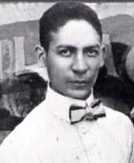Spanish Tinge

The phrase Spanish tinge is a reference to the belief that an Afro-Latin rhythmic touch offers a reliable method of spicing the more conventional 4/4 rhythms commonly used in jazz and pop music. The phrase is a quotation from Jelly Roll Morton. In his Library of Congress recordings, after referencing the influence of his own French Creole culture in his music, he noted the Spanish (read Cuban) presence:
Then we had Spanish people there. I heard a lot of Spanish tunes. I tried to play them in correct tempo, but I personally didn't believe they were perfected in the tempos. Now take the habanera "La Paloma", which I transformed in New Orleans style. You leave the left hand just the same. The difference comes in the right hand — in the syncopation, which gives it an entirely different color that really changes the color from red to blue.Now in one of my earliest tunes, "New Orleans Blues", you can notice the Spanish tinge. In fact, if you can't manage to put tinges of Spanish in your tunes, you will never be able to get the right seasoning, I call it, for jazz.
It is important to point out that what Morton described as a "Spanish" influence did not refer to cultural elements coming specifically from Spain. What he was calling "Spanish" was in fact the tresillo and habanera rhythms of the Cuban contradanza ("habanera"). We know this because Morton demonstrated the "tinge" to Alan Lomax in the 1938 Library of Congress recordings.[1] What is known in Latin music as the habanera rhythm (also known as the congo,[2] tango-congo,[3] and tango.[4]), and tresillo, are in fact, two of the most basic duple-pulse cells found in sub-Saharan African music traditions. They were brought to Cuba and elsewhere in the New World via the Atlantic slave trade.
Morton categorized his compositions in three groups: blues, stomps and Spanish tinge—for those with habanera rhythms. Tunes with the "tinge" include "New Orleans Blues", "La Paloma", "The Crave", and "The Spanish Tinge". Morton also called attention to the habanera in "St. Louis Blues" as one of the elements in the song's success.
Notable examples
Morton's maxim, usually given now as "You've got to have that Spanish tinge", has proven to be apt for many artists to this day. Afro-Cuban rhythms and musical instruments are employed by artists of all sorts. Many jazz and pop compositions express Spanish tinge, as well as other Cuban rhythmic elements such as clave. Cuban percussion instruments are also popular. Notable examples include:
- Juan Tizol's "Caravan" and "Perdido", first performed by Duke Ellington
- "Rum and Coca Cola" by the Andrews Sisters, an imported calypso
- the "blues rhumba" of Professor Longhair
- "Early in the Morning" and numerous calypso-style hits by Louis Jordan
- Afro-Cuban jazz, as adopted and promoted by Dizzy Gillespie, Mongo Santamaría, and many others
- The "Bo Diddley beat" is based on the clave rhythm, as are many other songs, such as "Not Fade Away" and "I Want Candy"
- "Little Darling" by The Gladiolas, with its insistent clave rhythm.
- "Under the Boardwalk" by The Drifters, produced by Jewish-American mambo aficionado Bert Berns with triangle, güiro, and castanets
- "What'd I Say", "I'm Moving On" (congas and maracas on a country and western cover), and many other Ray Charles songs
- "Twist and Shout", popularized by the Isley Brothers and later The Beatles; "Hang on Sloopy", a hit song by the pop group The McCoys; and Jimi Hendrix's "Wild Thing", all share the Cuban bassline and typical Cuban chord progressions.
- Chuck Berry's "La Juanda" and "Havana Moon"
- The boogaloo, a fusion of soul music with the Cuban mambo and son.
- Richard Berry's inspiration for "Louie Louie" came from René Touzet's song "El Loco Cha Cha". René Touzet was a major figure in Cuban music in the 1940s, beginning his career leading a 16-piece orchestra at Havana's Grand Nacional Casino
- The Rolling Stones' "Sympathy for the Devil", which is based on the Afro-Cuban tumbao rhythm
- Tom Waits' "Back in the Crowd", from his 2011 album Bad as Me
See also
- Latin music in the United States
References
- ↑ Morton, “Jelly Roll” (1938: Library of Congress Recording) The Complete Recordings By Alan Lomax.
- ↑ Manuel, Peter (2009: 69). Creolizing Contradance in the Caribbean. Philadelphia: Temple University Press.
- ↑ Acosta, Leonardo (2003: 5). Cubano Be Cubano Bop; One Hundred Years of Jazz in Cuba. Washington D.C.: Smithsonian Books.
- ↑ Mauleón (1999: 4)
- ↑ Garrett, Charles Hiroshi (2008). Struggling to Define a Nation: American Music and the Twentieth Century, p.54. ISBN 9780520254862. Shown in common time and then in cut time with tied sixteenth & eighth note rather than rest.
- ↑ Sublette, Ned (2007). Cuba and Its Music, p.134. ISBN 978-1-55652-632-9. Shown with tied sixteenth & eighth note rather than rest.
- Mr. Jelly Roll: The Fortunes of Jelly Roll Morton, New Orleans Creole and "Inventor of Jazz" by Alan Lomax. Jelly Roll's autobiography, largely drawn from Jelly Roll Morton the Complete Library of Congress Recording.
- Tom Waits in Interview with Tom Waits by Mark Richardson. Pitchfork Media, October 18, 2011

.png)